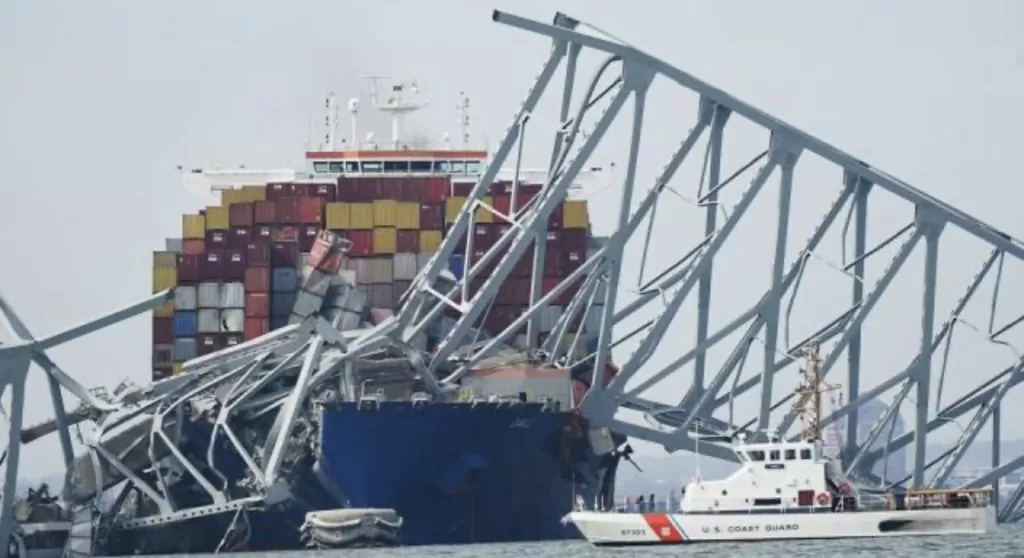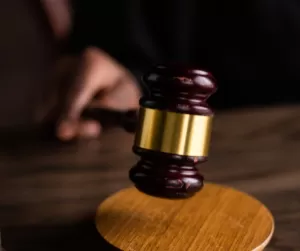What we know about the Baltimore bridge collapse

A massive cargo ship plowed into Baltimore’s Francis Scott Key Bridge early Tuesday, causing the 1.6-mile structure to crumble like a pile of toothpicks – plunging cars and people into the frigid water below.
The bodies of two people were recovered from the Patapsco River on Wednesday as officials searched the water. The men, a 35-year-old and a 26-year-old, were found trapped in a red pickup at the middle of the fallen bridge, according to the Maryland State Police.
Superintendent Col. Roland L. Butler said during a Wednesday news conference the search and recovery efforts have paused for the four additional people who were on the structure and they are presumed dead.
Here’s what we know about the catastrophe and what’s next:
Why did the bridge collapse?
Shortly before 1:30 a.m. Tuesday, a Singaporean-flagged container vessel called Dali struck one of the 47-year-old bridge’spillars, officials said.
There were 21 crew members and two pilots onboard the Dali cargo ship, National Transportation Safety Board Chair Jennifer Homendy said during a Wednesday news conference.
The ship is about 984 feet long – almost the length of three football fields. At the time of the crash, the Dali weighed 95,000 gross tons – or 213 million pounds – and was chartered to carry cargo by Danish shipping giant Maersk.
“Just minutes before (hitting) the bridge, there was a total blackout on the ship, meaning that the ship lost engine power and electrical power. It was a complete blackout,” said Clay Diamond, executive director and general counsel of the American Pilots Association.
The pilot then did “everything that he could have done” to slow the ship down and keep it from veering toward the bridge pillar, Diamond said.
Moments before the disaster, video footage shows the lights on the vessel flickering off and on – likely due to an emergency generator activating after the initial blackout, Diamond said. But the ship’s engines never turned on again.
Instead of crossing under the center of the bridge, where the clearance was highest, the ship drifted to the right and crashed into a pillar.
Incorporating redundancies is the preferred method of building bridges in present day, Homendy said. The bridge is one of 17,468 fracture critical bridges in the US out of 615,000 total bridges, she said, citing the Federal Highway Administration.
Homendy described the bridge as having been in “satisfactory condition,” and said its last fracture critical inspection was in May 2023.
Who are the victims?
Eight workers were on the bridge filling potholes when it collapsed. Two survived.
The bodies of two workers were recovered shortly before 10 a.m. on Wednesday and were identified as 35-year-old Alejandro Hernandez Fuentes, from Mexico, and 26-year-old Dorlian Ronial Castillo Cabrera, from Guatemala, said Butler, with the state police.
After a day-long search, officials called off the rescue mission Tuesday evening.
It was virtually impossible to survive the frigid, 50-foot-deep water after several hours, and it was too dangerous for divers to navigate the dark water amid sharp debris from the crash.
The victims include immigrants from Mexico, Guatemala, El Salvador and Honduras.
Search efforts for the other four workers have paused because additional vehicles are encased in concrete and other debris, making it unsafe for divers, Butler said Wednesday.
“Now, once that salvage effort takes place and that superstructure is removed, those same divers are gonna go back out there and bring those people closure,” Butler added.
Miguel Luna, a father of three from El Salvador who had lived in Maryland for more than 19 years, went to work on the bridge and never came home, according toCASA, a non-profit that provides critical services to working-class and immigrant families.
Maynor Yassir Suazo Sandoval, 38, was from Honduras but had been a US resident for the past 18 years, his brother told CNN. Suazo was married and had two children – an 18-year-old son and a 5-year-old daughter.
Two of the missing victims are Mexican nationals, according to Mexican President Andrés Manuel López Obrador.
But “we know our people are involved,” Rafael Laveaga, Chief of the Consular Section of Mexico’s Embassy in Washington, said. “It was a crew who was repairing parts of the potholes on the bridge, and they’re the ones who are going to build the bridge again – the Latinos.”
Two people who were on the bridge were rescued from the Patapsco River, Baltimore City Fire Chief James Wallace said Tuesday morning. One of them was not injured, and the other was taken to a trauma center. The hospitalized patient was later discharged, the University of Maryland Medical Center said.
Brawner Builders Executive Vice President Jeffrey Pritzker told CNN that among the eight people on the bridge were seven of his employees. Just one survived.
No one aboard the Dali vessel was injured, according to Synergy Group.
How dangerous is the water?
The Patapsco River under the Key Bridge was rife with hazards – for both the construction workers who vanished and for the rescue crews who tried to save them.
When crews arrived Tuesday morning, the surface water temperature of the Patapsco River was about 47 degrees, the fire chief said.
Any prolonged exposure to water under 55 degrees can be deadly, the National Weather Service said. Swimmers without floatation can survive in water temperatures of 40 to 50 degrees for about 30 to 60 minutes, according to the University of Minnesota.







